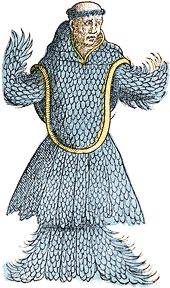Gesner reproduced this picture of a Sea Devil (also called Triton marinus, Dæmon marinus, Satyrus marinus or Pan marinus) because the artist sending him the picture "had seen the monster alive." Gesner noted that one such creature had been captured in Norway and another in Rome. The Roman Sea Devil, he pointed out, didn't have horns. Gesner was such a prolific natural historian thanks largely to a wide network of associates. Unfortunately, many of them were superstitious mariners. This improbable creature is probably based on the monk seal. Once common in the Mediterranean, the species was decimated by human hunting. Fishermen considered the seals a smelly nuisance. So, apparently, did farmers. As Aristotle had a millennium earlier, both Gesner and fellow naturalist Ulisse Aldrovandi passed along accounts of seals raiding orchards
The Mediterranean monk seal is Europe’s most endangered marine mammal – but why? What has made it so?
Taken at face value, the evidence has always appeared to implicate the grinding ecological pressures that ‘algae-bloomed’ during the 20th century – overfishing and destructive fishing methods, rampant coastal development, the locust swarms of summer tourists and boaters, the toxic ooze of industrial and agricultural pollution.
A reading of more distant history, however, tells a somewhat different story, and arguably delivers a lesson as pertinent today as it was two millennia ago, when ancient Rome first witnessed the spectre of overfishing, erosion, urban overcrowding, forest denudation and the disappearance of species.
In ancient minds
Although it may be thought of as an obscure species today, its very survival hanging by a thread, the Mediterranean monk seal has appeared in numerous writings inked onto papyrus, parchment or paper during the last 3000 years.
While most Europeans today are scarcely even aware of its existence, the seal formerly touched the lives of many, including emperors, poets, philosophers, sorcerers, physicians, explorers and, of course, fishermen.
Homer, Aristotle, Hippocrates, Plutarch, Galen, Avicenna and Gesner are among some of the ancient and Renaissance world luminaries who recorded observations about the Mediterranean seal and its relationship to human culture, folklore, science and economy.
Monk seal colonies were once found throughout the Mediterranean, the Marmara and Black Seas. The species also frequented the Atlantic coast of Africa, as far south as Mauritania, Senegal and the Gambia, as well as the Atlantic islands of Cape Verde, the Canary Islands, Madeira and the Azores. It is likely that across its original range, the Mediterranean monk seal once numbered in the tens of thousands.
Today, several thousand years later, fewer than 600 individuals are thought to survive, mainly in two disconnected populations, one along the mainland coasts and islands of Greece and Turkey in the eastern Mediterranean, and the other in the Atlantic, along the cliff-bound coasts of the disputed Western Sahara.
France, Spain, Italy, Egypt, Israel and Lebanon are among some of the nations that saw the disappearance of the species during the 20th century. More recently, the monk seal is also thought to have become extinct in the Black Sea. Despite sporadic sightings – possibly of stragglers from other regions – Monachus monachus is also effectively extinct along the Adriatic coasts and islands of Croatia, and the Sea of Marmara. Similarly, only a handful of individuals now reportedly survives along the Mediterranean coasts of Tunisia, Algeria, Libya and Morocco.
Myths and legends
In Greek mythology, monk seals were placed under the protection of Poseidon and Apollo because they showed a great love for sea and sun
animistic imaginations transformed the creatures into nymphs and mermaids.
Several Greek and Roman texts also link the animals to the myth of the Sirens and the sweet, irresistible song that could reputedly lure sailors to their doom. Recently discovering some grains of truth to the ancient legend, field researchers have noted the high-pitched, siren-like cry that mother seals make in warning their pups of danger, the sound echoing out from desolate, cliff-bound coasts. [see The Song of the Sirens, this issue]One of the first coins, minted around 500 B.C. by the powerful city state of Phocaea – itself named after the species – depicted the head of a monk seal.
In recent excavations on the island of Rhodes, archaeologists discovered the skeleton of a monk seal ceremonially buried next to a dog and several humans; they theorise that the seal may have become a pet who received honoured burial rites after its death.
Magic and superstition
Like many other wild species, the seal was also prized for its uses in magic and superstition – even if it was difficult, under the influence of the Magian sorcerer-healers, to tell magic from medical practice.
Because of its infamously sleepy habits, the right flipper of a seal, placed under the pillow, was thought to cure insomnia. The whiskers, distilled into a potion, could win friends and lovers or drive off enemies.
Since the seal was never known to be struck by lightning, Roman tents were covered with seal hides.
Such superstitions were not only confined to poor fisher folk, farmers, or even the legions. The Roman biographer and historian, Suetonius, tells us that thunder and lightning also struck terror into the most powerful figure of the Empire, Caesar Augustus, “against which he always carried a piece of seal-skin as an amulet.”
Plutarch adds that ship-owners had their mastheads wrapped in seal pelts, in the belief that they would offer protection against lightning strikes. When allied with the apotropaic powers of coral, the skins were also reputed to guard against supernatural forces, protecting vessels against perilous winds, waves and storms.
Such superstitions also made their way into other walks of life.
According to a fourth century A.D. treatise on agricultural pursuits, a seal pelt dragged around a field and then hung at the entrance or yard would save a farmer’s crops from hail storms
Post Title
→The Sea Devil
Post URL
→http://beautykimkardashian.blogspot.com/2010/05/sea-devil.html
Visit Beauty Kim Kardashian for Daily Updated Beauty Kim Kardashian







.jpg)